| |
Click on the maps for larger image |
| |
|
| National Surface Meteorological Networks |
| |
|
| Automated Surface Observing System (ASOS) - The National Weather Service (NWS),
Federal Aviation Administration (FAA) and Department of Defense operate this network of 968
stations located throughout the United States (48 in Alaska). The data generally available
from ASOS stations includes hourly (and special) observations of air temperature, dew point, wind
speed, wind direction, cloud cover, visibility, present weather, and precipitation. Via modem
data can be obtained every minute (typically the most recent ~8 hours of observations are kept at
the stations). For further information on the
NWS ASOS home page or the
FAA Automated Sensors home page. |
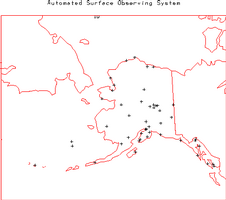 |
| |
|
| Automated Weather Observing System (AWOS) - The FAA and various state agencies
(particularly Aviation Divisions of state Departments of Transportation) operate this network of
900 stations located throughout the United States (66 in Alaska). While data is generally
available from 552 of these stations (55 in Alaska), the data from the other 348 stations (11 in Alaska) is
currently only available via dialup modem (typically the most recent ~3 weeks of observations
are kept at the stations). These stations typically provide 20-minute observations of air
temperature, dew point, wind speed, wind direction, cloud cover, visibility, altimeter setting,
present weather and precipitation. For further information on the AWOS network visit the
FAA Automated Sensors home page. |
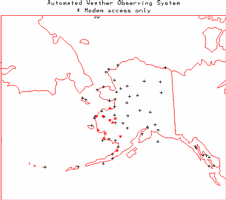 |
| |
|
| Other METAR Reports - In addition to the ASOS and AWOS there are a number
of other observation stations that provide. These include several military stations and sites
that report manual observations. There are 249 such observation
locations located throughout the United States (33 in Alaska). A large proportion of these
observations are limited in some fashion (e.g. no observations at night or just one or two
observations in a day). The parameters available vary from station to station, but most provide
air temperature, dew point, wind speed, wind direction, cloud cover, and present weather. |
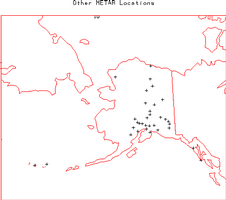 |
| |
|
| NOAA/NWS Cooperative Observer Program - The National Oceanographic and
Atmospheric Administration (NOAA) National Weather Service (NWS) oversees this network with
11852 participating cooperative observers located throughout the United States (297 in
Alaska). This network provides daily observations (7am local time) of maximum and minimum
air temperature, precipitation, snowfall, and snow depth. Some stations also provide soil
temperature, evaporation, and wind run. These data are archived at NOAA/NCDC. For further
information visit the
NOAA/NWS Cooperative
Observer Program home page. |
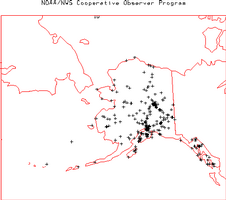 |
| |
|
| Citizen Weather Observer Program (CWOP)
- This 'network' is comprised of weather stations operated by the general public and
reported by amateur radio operators around the world. All observations are collected
by the NOAA/Forecast Systems Laboratory (NOAA/FSL) and are included as part of their
Meteorological Assimilation Data Ingest System (MADIS). The network varies greatly in
terms of data quality and completeness. Within the United States there are
1328 reporting stations (6 in Alaska). The parameters reported
vary by station, but typically include air temperature, relative humidity, wind speed,
wind direction, barometric pressure, and precipitation. For further information
visit the
CWOP home page. |
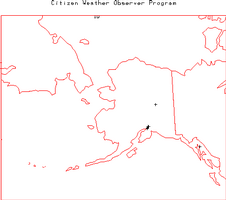 |
| |
|
| Remote Automated Weather Station (RAWS) Network - The United States Forest
Service oversees this network of stations owned and operated by state and local wildland fire
agencies. The network typically provides hourly values of air temperature, dew point,
relative humidity, wind speed, wind direction, precipitation, fuel temperature, and fuel
moisture. The network consists of 726 stations located throughout the United States (42 in
Alaska), but heavily concentrated in the forested areas of the western mountains. These
data are included within the University of Utah
MesoWest
and the NOAA/FSL
MADIS data sets.
For further information visit the
USFS RAWS home page.
The Western Region Climate Center has a
RAWS USA Climate Archive.
The Alaska Fire Service also has a
Fire Weather
Database. |
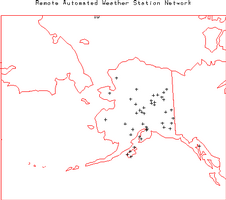 |
| |
|
| Hydrometeorological Automated Data System (HADS) - The NOAA Office of
Hydrologic Development operates the HADS real-time data aquisition and data distribution
system. HADS collects data from Data Collection Platforms (DCPs) operated by a number of
federal, state, and local agencies throughout the US and a few nearby countries. The
network currently includes 10079 observation locations (180 in Alaska). The temporal
resolution and parameters collected vary widely by network and station but can include a
variety of meteorological and hydrologic parameters. For further information visit the
NWS HADS page. |
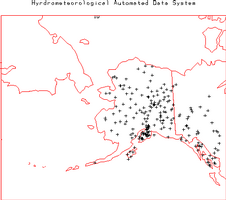 |
| |
|
| Long Term Ecological Research (LTER) Network - The LTER network
was set up by the National Science Foundation to allow investigation of ecological
processes at long time scales and over broad spatial scales. Each of the 21 (2 in
Alaska) LTER sites typically has at least one automated surface meteorological station.
Many also have several meteorological stations, precipitation networks, and/or flux
towers. The LTER sites in Alaska are the
Arctic LTER site located in
the foothills region of the North Slope of Alaska and the
Bonanza Creek LTER site located in
the boreal forests of interior Alaska.
For further information visit the
LTER home page. |
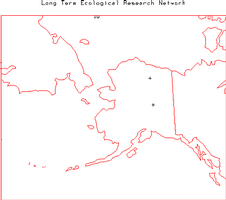 |
| |
|
| Coastal-Marine Automated Network (C-MAN) -
The National Data Buoy Center (NDBC) operates this network of 55 C-MAN stations
with locations along coastlines throughout the US (7 in Alaska). The network
typically provides hourly observations of air temperature, barometric pressure,
wind speed, wind direction, and wind gust. Some stations also provide
observations of sea water temperature, water level, waves, relative humidity,
precipitation, and visibility. For further information visit the
NDBC home page. |
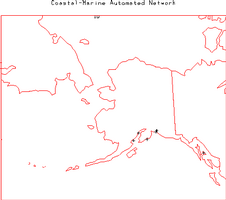 |
| |
|
| National Data Buoy Center (NDBC) Moored Buoy
Network - The NDBC operates this network of 77 moored buoys with locations
throughout the US coastal regions (10 off the coast of Alaska). The network typically
provides hourly observations of air temperature, dew point, water temperature,
barometric pressure, wind speed, wind direction, wave height, wave period, and
swell. For further information visit the
NDBC home page. |
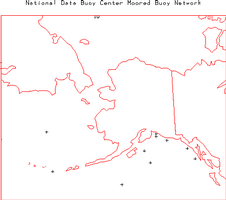 |
| |
|
| Regional Surface Meteorological Networks |
| |
|
| Not presently aware of any. |
|
| |
|
| State and Local Surface Meteorological Networks |
| |
|
| Road Weather Information System (RWIS) - The Alaska Department of
Transportation (DOT) operates this network of 40 stations with locations throughout
Alaska. The network provides variable temporal resolution observations of
air temperature, dew point, relative humidity, wind speed, wind direction, wind gust,
and precipitation (only yes/no and sometimes precipitation type). For further information
visit the
AK DOT RWIS home page. This network is also included in the NOAA/FSL
MADIS data set. |
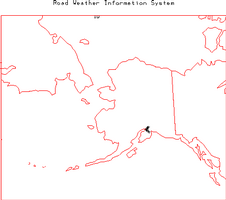 |
| |
|
| Juneau Airport Wind System (JAWS) - JAWS is a prototype version of a
turbulence alerting system. There are currently three wind profilers and seven surface
weather stations included in the network around the Juneau, AK airport. The weather
stations provide one minute resolution measurements of wind speed, wind direction, wind gust and
temperature. The wind profilers provide 10 minute resolution vertical profiles of wind
speed and wind direction. For further
information visit the JAWS
home page. |
No map. |
| |
|
| Neighborhood Environmental Watch Network (NEWNET) -
The Los Alamos National Laboratory, Alaska Department of Environmental Conservation,
the University of Alaska Fairbanks, the US Environmental Protection Agency, and local
communities operate this network of 28 stations (6 in Alaska) to provide radiological and
meteorological data. The network provides 15-minute observations of wind speed, wind
direction, barometric pressure, air temperature, relative humidity, precipitation, and
radiological parameters. For further information visit the
NEWNET home page. |
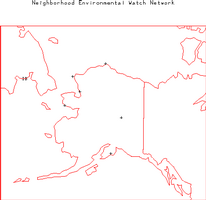 |
| |
|
| Caribou Poker Creeks Research Watershed Meteorological Stations
- The University of Alaska Fairbanks Water and Environmental Research Center operates
this network of 4 meteorological stations located in the Caribou and Poker Creek Research
Watershed to the north of Fairbanks, Alaska. The parameters measured vary by site but
can include hourly observations of wind speed, wind direction, air temperature, relative
humidity, net radiation, up/downward long/shortwave radiation, barometric pressure,
precipitation, and snow depth. For further information visit the
network home page. |
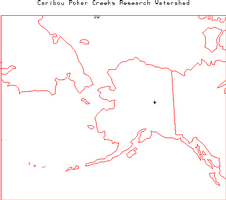 |
| |
|
| Seward Peninsula Hydrometeorology Network - The University of Alaska Fairbanks Water and Environmental Research
Center operates this network of 8 meteorological stations located on the Seward
Peninsula in western Alaska. The parameters measured vary by site but can include hourly
observations of wind speed, wind direction, air temperature, relative humidity, net
radiation, up/downward long/shortwave radiation, barometric pressure, precipitation, and
snow depth. For further information visit the
Network home page. |
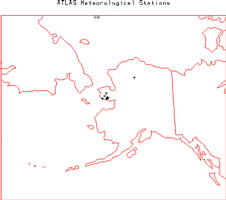 |
| |
|
| Prince William Sound Network (PWSN) - The Prince William Sound
Watershed operates this network of 8 stations located throughout Prince William
Sound in southern Alaska. Most stations provide hourly observations of air temperature,
relative humidity, wind speed, wind direction, and barometric pressure. For further
information visit the
PWSN home page. |
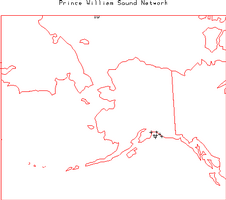 |
| |
|
| Alaska Railroad Network - Alaska Railroad operates this network of 7
stations located to the south of Anchorage, Alaska. It also collects data from other
networks in the same region. The parameters vary by stations, but can include hourly
observations of air temperature, relative humidity, wind speed, wind direction, wind
gust, snow depth, and precipitation. For further information visit the
Chugach National Forest Avalanche Information Center weather data page. |
Map at web site. |
| |
|
| Anchorage Mesonet - The Anchorage, Alaska National Weather Service
Forecast Office collects data from 7 meteorological stations located in the greater
Anchorage area. These stations are operated by a number of organizations. The network
has a varying set of parameters at each stations, but observations can include hourly
observations of air temperature, dew point, relative humidity, wind speed, wind direction,
and altimeter setting. For further information visit the
Anchorage Mesonet home
page. |
No Map. |
| |
|
| Alaska Telemetry Sites - Not much information about these. Parameters vary
by station, but can include temperature, precipitation, snow depth and snow water content.
For further information and map of sites visit the
Alaska Snow, Water and Climate Services
Alaska Telemetry Sites web page. |
No Map. |
| |
|
| Fairbanks Mesonet - A number of agencies operate the 17 stations in this
network located in the greater Fairbanks area. The network has a varying set of parameters
at each station, but observations can include hourly observations of air temperature, dew
point, relative humidity, wind speed, wind direction, and pressure as well as other
meteorological, hydrological, and geotechnical parameters. For further information visit the
Fairbanks Mesonet home page. |
No Map. |
| |
|
| Mt. Mckinley Weather Station - The University of Alaska Fairbanks International
Arctic Research Center operates this weather station just south of Denali Pass at nearly 19,000 ft
elevation. The station provides hourly observations of temperature (multiple sensors), pressure,
wind speed and wind direction. For further information visit
The Mt. McKinley Weather Station web site. |
No Map. |
| |
|
| HAARP Weather Station - The High frequency Active Auroral Research Program
(HAARP) operates this weather station near Gakona, AK in south central Alaska. The station
provides 15 minute observations of temperature, relative humidity, station pressure, wind
speed, wind direction and precipitation. For further information visit the
HAARP Data web page. |
No Map. |
| |
|
| University of Alaska Southeast Fish CreekWeather Station - The University of
Alaska Southeast operates this weather station at the Fish Creek study site at 58 15.691'N
and 134 31.044'W. The station provides 1-minute observations of temperature, wind speed,
snow depth and other parameters. For further information visit the
Fish Creek weather station web
site. |
No Map. |
| |
|
| Precipitation and Radar Networks |
| |
|
| NOAA/National Centers for Environmental
Prediction (NCEP) Hourly Precipitation Data - NOAA/NCEP routinely develops
a National Multi-sensor Hourly Precipitation Analysis (Stage II) data set from
hourly radar precipitation estimates and from hourly gage reports. The gage data
includes hourly observations from 4824 gages across the US (52 in Alaska)
collected by the NOAA River Forecast Centers and sent to NCEP. Further information
on these data is available from the
NCEP
Hourly Precipitation Analysis home page. |
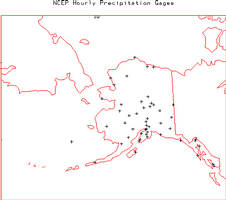 |
| |
|
| NOAA/NWS Cooperative Observer 15-minute Precipitation Network - The
NOAA/NWS
routinely collects 15-minute observations of precipitation from Fisher-Porter and Universal
rain gages operated by 3421 cooperative observers located throughout the US (30 in Alaska).
These data are archived at NOAA/National Climatic Data Center (NCDC) as data set TD 3260.
For further information visit the
NOAA/NCDC TD3260 page. |
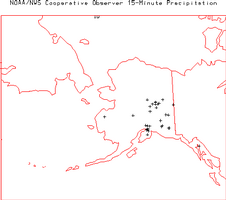 |
| |
|
| Snowpack Telemetry (SNOTEL) Network - The United States Department of
Agriculture Natural Resources Conservation Service (NRCS) operates this network of 754
stations with locations throughout the mountainous areas of the western US (72 in
Alaska). The temporal resolution and parameters measured vary by station. Up to hourly
observations of air temperature, precipitation, snow depth, and snow water content are
typically provided. Other parameters that may be available include relative humidity, wind
speed, wind direction, solar radiation, soil moisture, and soil temperature. These data
are archived by the NRCS, Western Regional Climate Center, and other. For further
information visit the
NRCS SNOTEL Data Network
home page or the
Western Regional Climate Center SNOTEL data page or the
US Bureau
of Reclamation SNOTEL page. |
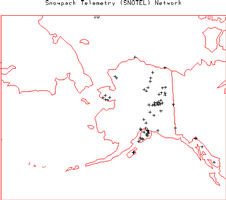 |
| |
|
| USDA/NRCS Snow Survey Program - The USDA/NRCS Snow Survey Program
provides mountain snow course data at approximately 800 locations throughout the
western US. For further information visit the
USDA/NRCS Snow
Course Data Network page and the
USDA/NRCS Alaska Snow, Water and Climate
Service page. |
Map
here. |
| |
|
| Weather Surveillance Radar 1988 Doppler (WSR-88D)
Network - The NOAA/NWS and the Department of Defense operate this network
of 154 WSR-88D radars across the US (7 in Alaska). The Level II
data are the three meteorological base data quantities (reflectivity, mean radial
velocity, and spectrum width) and are recorded at all NWS and most DOD sites.
Level II data are then processed in order to create a number of meteorological analysis
products known as Level III data. Level III data are recorded at the NWS sites. The
Level III products included base reflectivity, base spectrum width, base velocity,
composite reflectivity, echo tops, velocity azimuth display (VAD) wind profile,
vertically integrated liquid (VIL), 1-hour precipitation, storm total precipitation,
hail index overlay, mesocyclone overlay, severe weather probability overlay, storm
structure, storm tracking information overlay, and tornadic vortex signature overlay.
All Level II and III data are archived at NOAA/NCDC and can be retrieved from the
HDSS Access System (HAS). For further information visit
the
NOAA/NCDC Radar Resources page or the
NOAA Radar Operations Center. |
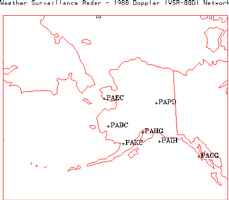 |
| |
|
| Radiation and Flux Networks |
| |
|
| Ameriflux Network - The Ameriflux network consists of 55 sites conducting
long-term measurements of CO2, water and energy fluxes throughout the US (3 in Alaska).
The typical observational frequency is 30 minutes. The parameters measured at each site
vary, but Ameriflux has defined a core set of parameters that most sites collect, including
fluxes of CO2, energy and water, basic meteorological and radiation parameters, and soil
temperature and moisture. For further information visit the
Ameriflux home page. |
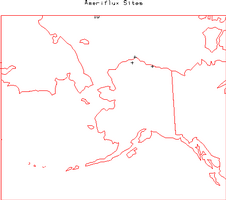 |
| |
|
| Soil Networks |
| |
|
| Soil Climate Analysis Network (SCAN) - The SCAN is operated by the United
States Department of Agriculture (USDA) Natural Resources Conservation Service (NRCS). The
network provides hourly observations of air temperature, relative humidity, wind speed,
wind direction, solar radiation, precipitation, barometric pressure, snow water content,
snow depth, soil temperature (at 2, 4, 8, 20, and 40 cm depths), and soil moisture (at 2, 4,
8, 20 and 40 cm depths). The 81 SCAN stations are located across the US in primarily
agricultural regions (6 in Alaska). For further information visit the
SCAN home page. |
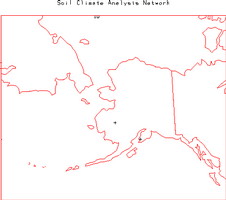 |
| |
|
| Hydrology Networks |
| |
|
| United States Geological Survey (USGS) Streamflow
Network - The USGS (part of the US Department of the Interior) operates this
network of 7237 streamflow gages (180 in Oregon) at locations throughout the US.
The network provides hourly or more frequent observations of stage (water level) from
which discharge (flow) is computed using a stage-discharge rating relation. The
rating is defined by occasional direct current-meter measurements of discharge. All
data are available through the USGS and the district offices in each state. Many of
these gages provide realtime data
relayed via the GOES satellite data collection system. The realtime data are
provisional data that have not been reviewed or edited. These realtime data
may be subject to significant change and are not citeable until reviewed and approved
by the USGS. Realtime data may be changed after review because the stage-discharge
relationship may have been affected by: 1) backwater from ice or debris; 2) algal and
aquatic growth in the stream; 3) sediment movement; and 4) malfunction of recording
equipment. Each station record is considered provisional until the data are
published. The data are usually published with 6 months of the end of the water year
(1 October to 30 September). Data users are cautioned to consider carefully the
provisional nature of the information before using it. For further information on the
USGS streamflow network visit the
USGS Water Resources of the United
States page or the
USGS Alaska District Office home
page. |
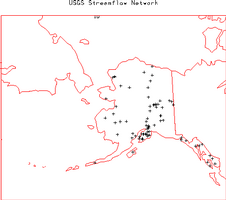 |
| |
|
| Upper Air Networks |
| |
|
| NOAA/NWS Radiosonde Network Low Vertical Resolution Data - The NOAA/NWS
typically releases radiosondes twice per day at 0000 and 1200 UTC at 85 locations throughout
the US (13 in Alaska). During special weather situations the NWS can request to release
additional radiosondes at off-times (e.g. 1800 UTC). The low resolution data is sent out
over the Global Telecommunications System (GTS) and provides mandatory and significant level
observations of pressure, altitude, temperature, dew point, wind speed, and wind direction.
There are 3 types of radiosondes utilized within the US network, Vaisala, VIZ (or Sippican),
and Microsonde. These data are archived by NOAA/NCDC and other organizations. For further
information on the NWS Radiosonde network visit the
NWS Upper-air Observations Program
home page. A several year archive of GTS upper air data is available at the
NOAA/FSL Radiosonde Database. |
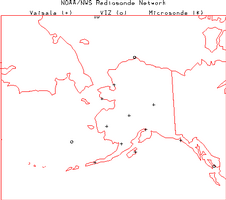 |
| |
|
| NOAA/NWS Radiosonde Network High Vertical Resolution Data - The same
radiosonde locations mentioned in the previous data set also provide a 6-second vertical
resolution data set that provides observations of pressure, temperature, altitude,
relative humidity, and azimuth and elevation angles. UCAR/JOSS has developed software
to derive 6-second vertical resolution winds from the angle data. These data are
archived by NCDC and UCAR/JOSS. |
 |
| |
|
| NOAA Profiler Network (NPN) - The
NOAA/Forecast Systems Laboratory (FSL) operates this network of 35 404 MHz wind
profilers primarily across the central portion of the United States (3 in Alaska).
Each site provides 6-minute and hourly vertical profiles of wind speed and wind
direction. Additionally, 11 of the NPN sites have a collocated Radio Acoustic
Sounding System (RASS) that provides 6-minute and hourly vertical profiles of
virtual temperature (none in Alaska). For further information visit the
NPN home
page. |
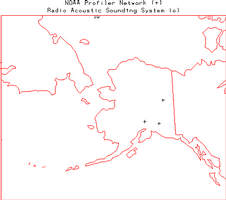 |
| |
|
| Juneau Airport Wind System (JAWS) - JAWS is a prototype version of a
turbulence alerting system. There are currently three wind profilers and seven surface
weather stations included in the network around the Juneau, AK airport. The weather
stations provide one minute resolution measurements of wind speed, wind direction, wind gust and
temperature. The wind profilers provide 10 minute resolution vertical profiles of wind
speed and wind direction. For further
information visit the JAWS
home page. |
No map. |
| |
|
| Ground Based Global Positioning System (GPS) Meteorology Demonstration Network
(GPS-MET) - The NOAA/FSL ingests data from 323 GPS locations around the US
operated by many different agencies (6 in Alaska). Typically each location provides
30-minute observations of integrated precipitatable water along with a number of surface
meteorology parameters (air temperature, relative humidity, barometric pressure, etc).
For further information visit the
GPS-MET home page. |
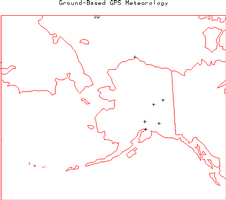 |
| |
|
| Coastal Networks |
| |
|
| Alaska Ocean Observing System (AOOS) - AOOS is the umbrella regional association
for multiple Alaska regional observing networks that are being developed as part of the national
Integrated Ocean Observation System (IOOS). For further information visit the
AOOS home page. |
No map. |
| |
|
| Coastal-Marine Automated Network (C-MAN) -
The National Data Buoy Center (NDBC) operates this network of 55 C-MAN stations
with locations along coastlines throughout the US (9 in Alaska). The network
typically provides hourly observations of air temperature, barometric pressure,
wind speed, wind direction, and wind gust. Some stations also provide
observations of sea water temperature, water level, waves, relative humidity,
precipitation, and visibility. For further information visit the
NDBC Alaska web page. |
Map at web site. |
| |
|
| National Data Buoy Center (NDBC) Moored Buoy
Network - The NDBC operates this network of 77 moored buoys with locations
throughout the US coastal regions (13 off the coast of Alaska). The network typically
provides hourly observations of air temperature, dew point, water temperature,
barometric pressure, wind speed, wind direction, wave height, wave period, and
swell. For further information visit the
NDBC Alaska web page. |
Map at web site. |
| |
|
| Deep Ocean Assessment and Reporting of Tsunamis (DART) Network - The NDBC operates
this network of buoys primarily for the early detection of tsunamis in the open ocean. DART
was developed by the NOAA Pacific Marine Environmental Laboratory (PMEL). It provides 15
minute observations of water column height. There are four off the southern coast of Alaska.
For further information visit the
NDBC Alaska web page. |
Map at web site. |
| |
|
| National Water Level Observation Network (NWLON) - The National
Ocean Service (NOS) Center for Operational Oceanographic Products and Services (CO-OPS)
maintains a long-term database containing water-level
measurements and derived tidal data. NWLON provides water level observations at 318
locations throughout the United States (6 in Alaska). Some stations provide additional measurements
including air and water temperature, pressure and winds. For additional information
visit the NWLON web page or
the NDBC Alaska web page. |
Map at web site. |
| |
|
| Aerosol Networks |
| |
|
| Aerosol Robotic Network (AERONET) - AERONET is an optical ground-based aerosol
monitoring network and data archive supported by NASA's Earth Observing System. The network
hardware consists of identical automatic sun-sky scanning spectral radiometers owned by national
agencies and universities. Data from this collaboration provides globally distributed (2 in Alaska)
near real time observations of aerosol spectral optical depths, aerosol size distributions and precipitable
water. For further information visit the
AERONET home page. |
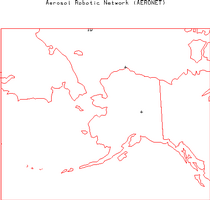 |
| |
|
| Micro-Pulse Lidar Network (MPLNET) - MPLNET is comprised of ground-based lidar systems
that are co-located with sun/sky photometer sites in the NASA AERONET. Basic data from the MPL include
aerosol and cloud layer heights. The primary purpose of MPLNET is to acquire long-term observations of
aerosol and cloud vertical structure at sites around the world (1 in Alaska). For further information
visit the MPLNET home page. |
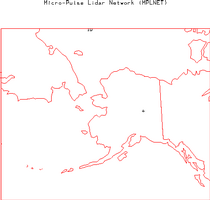 |























































